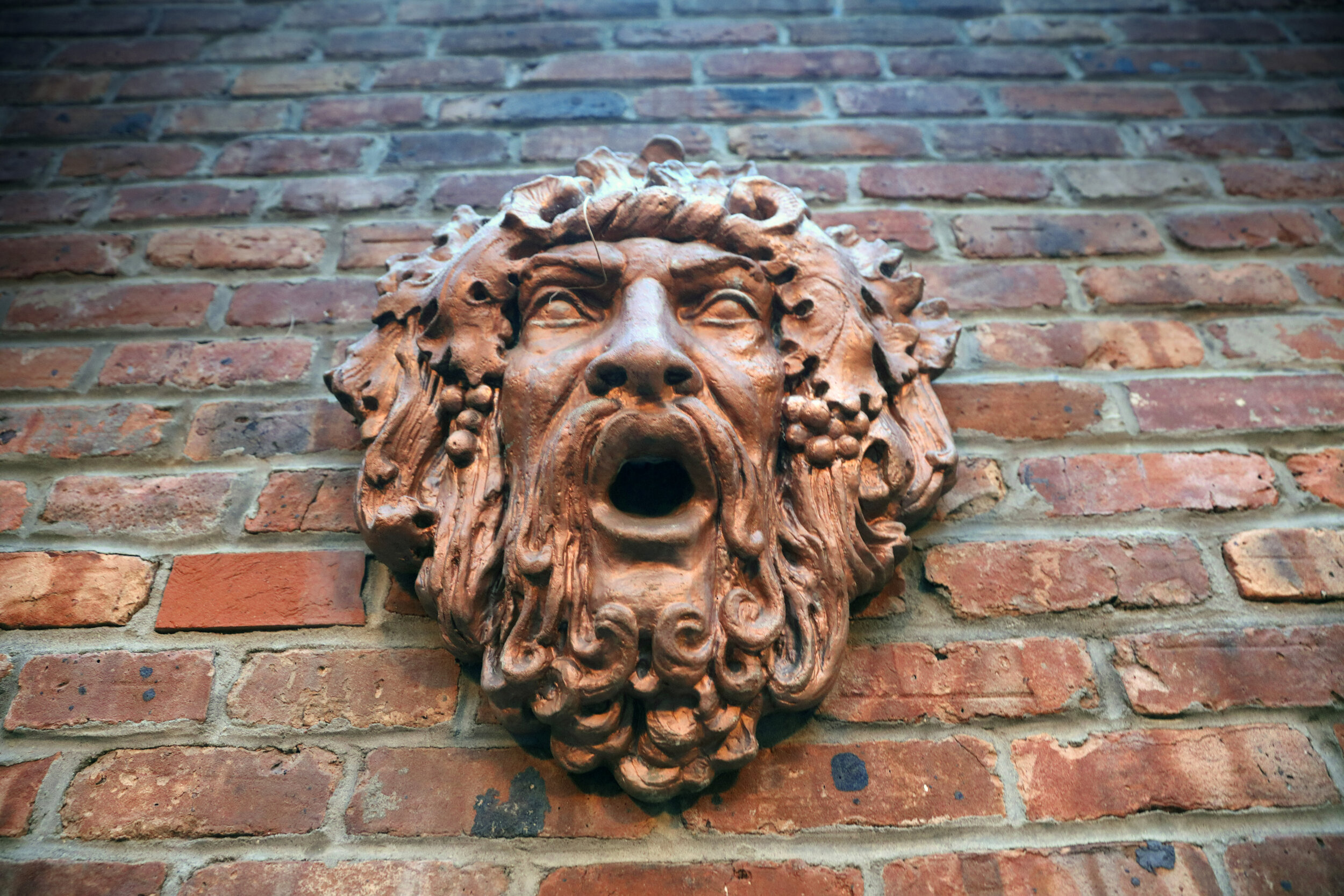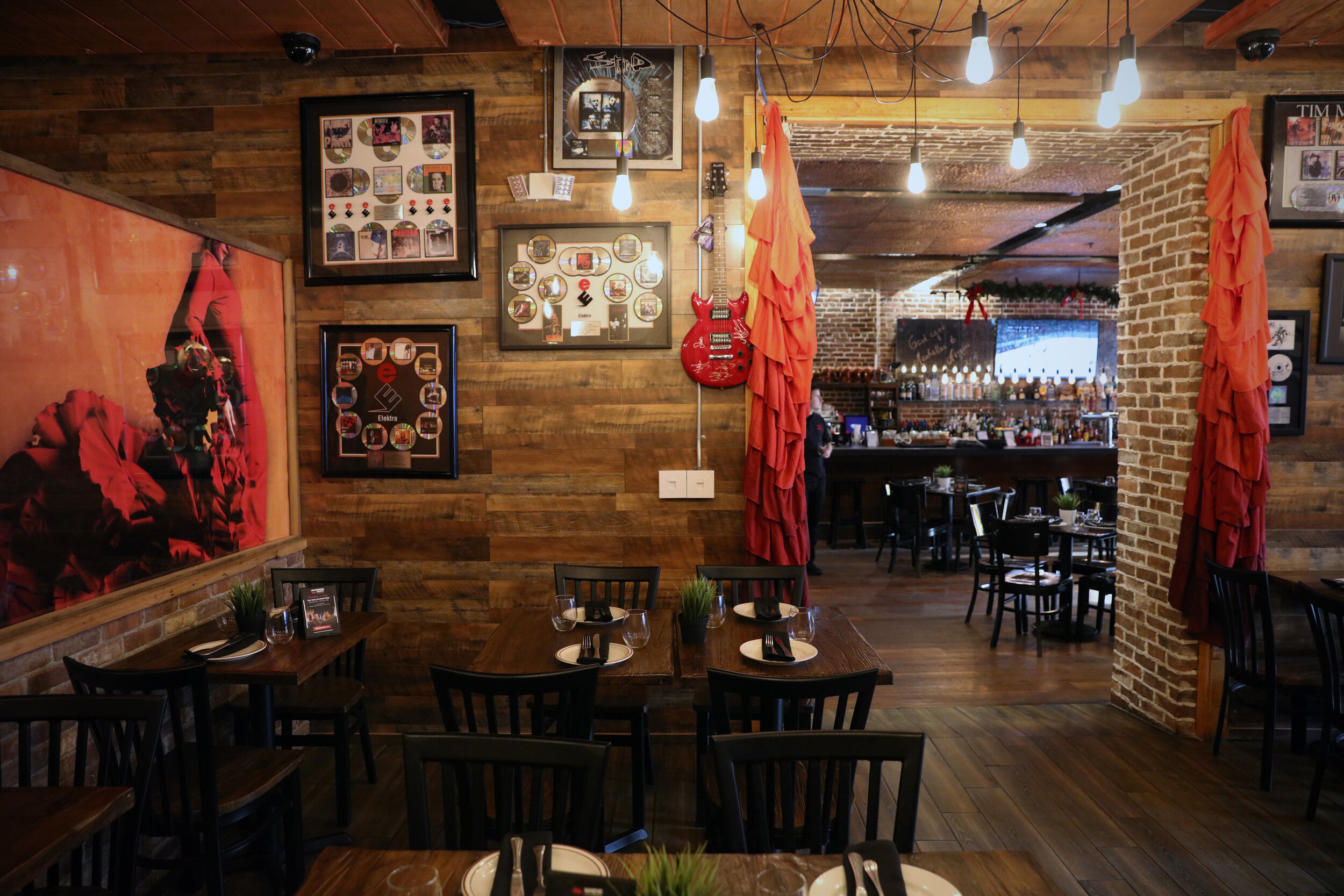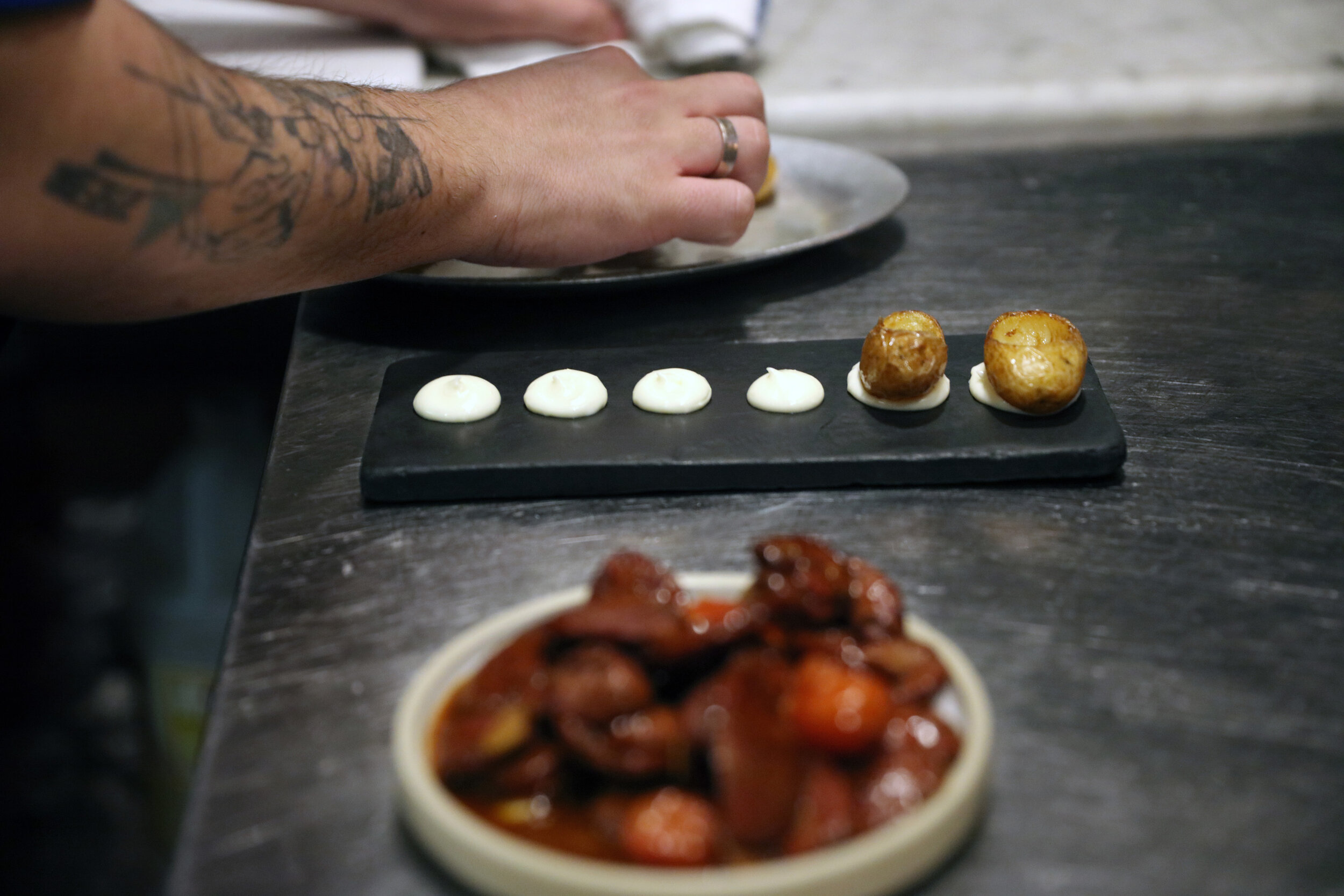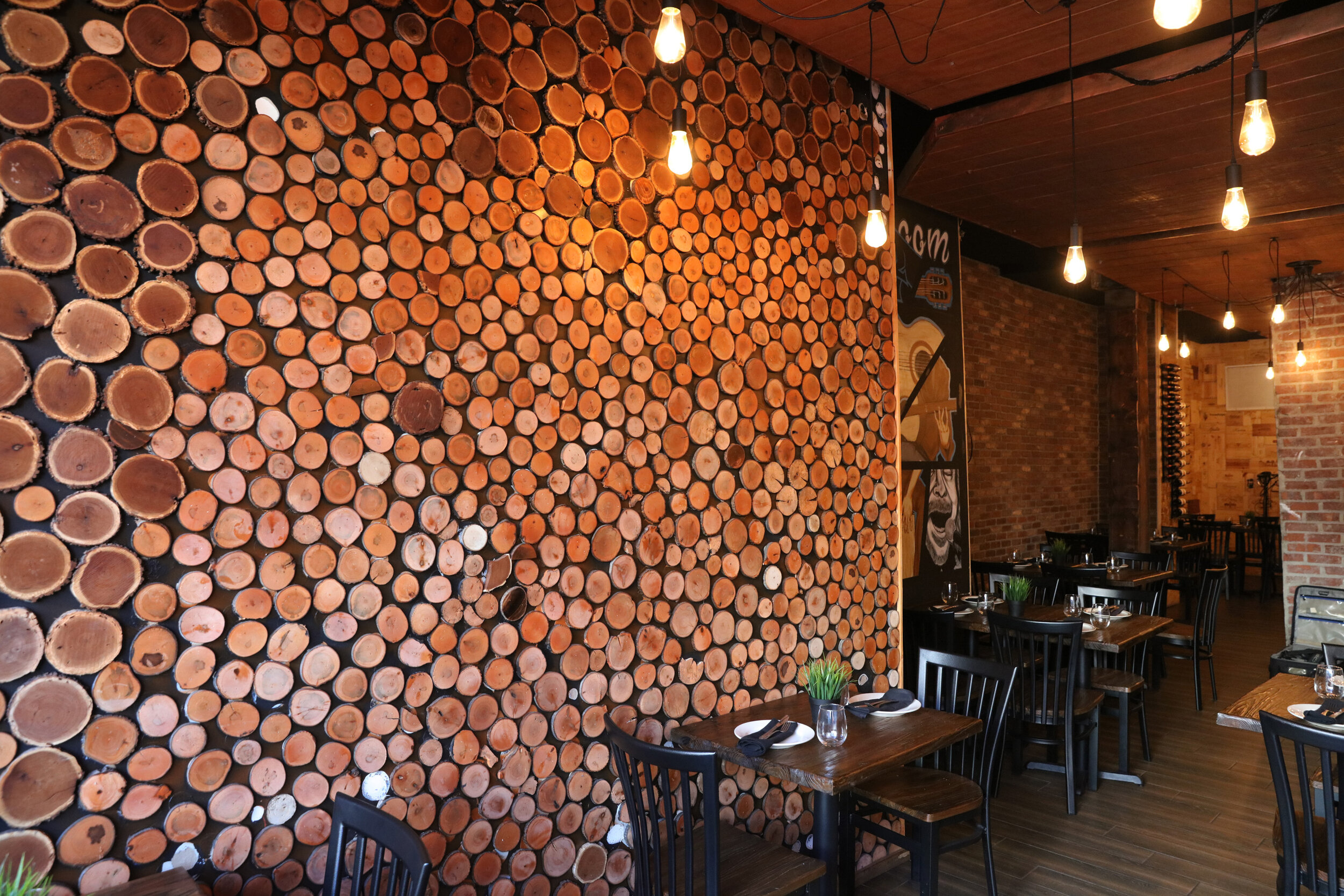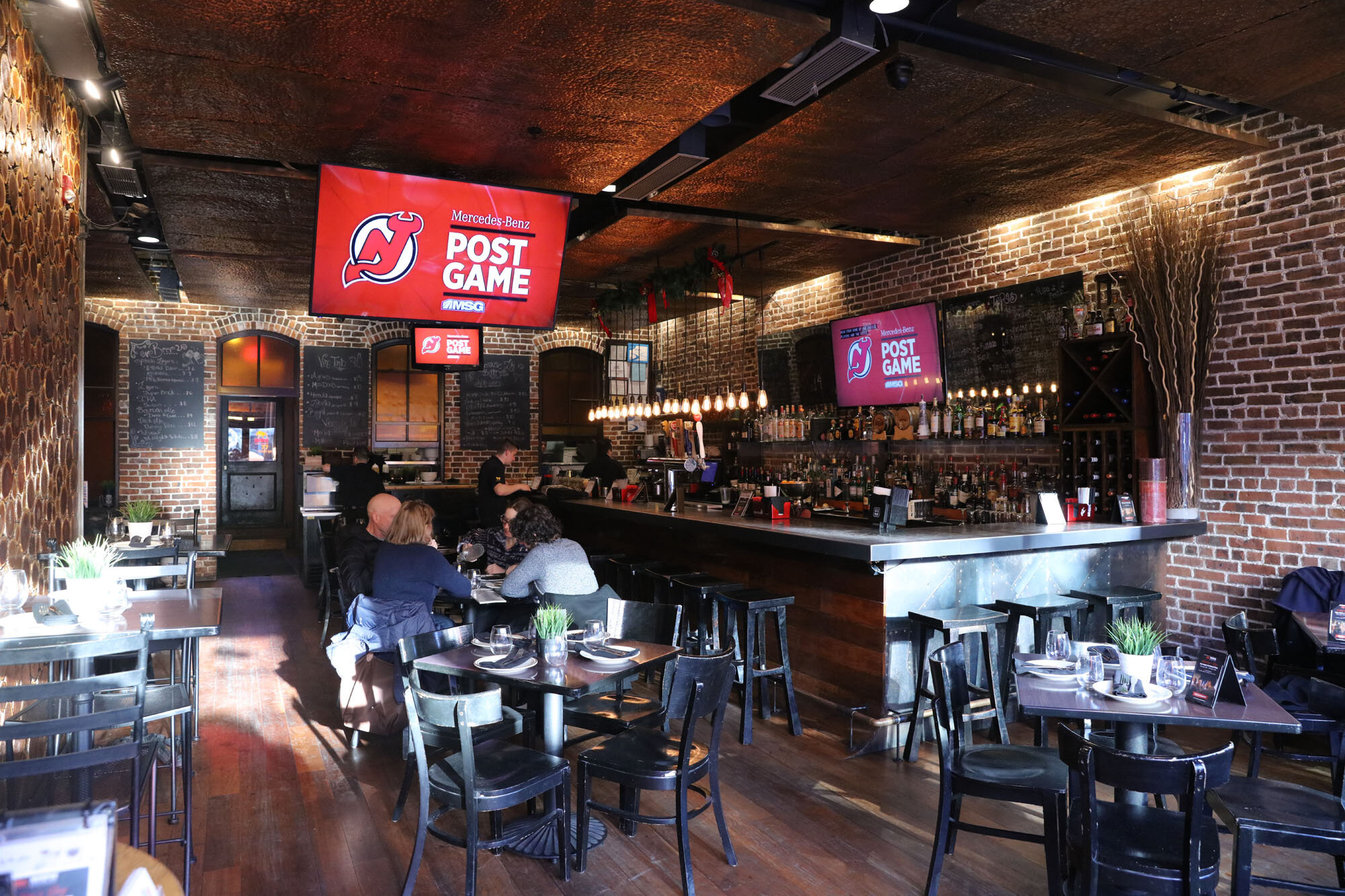Mompou’s website identifies the restaurant as “a trendy spot with Spanish tapas, wine, beer & cocktails plus a back patio & occasional live music.” Named after Spanish composer Federico Mompou, the restaurant’s Barcelona-style tapas menu reflects the Catalan heritage of its namesake. While Mompou takes advantage of an opportune location along Ferry Street — a 10-minute walk from Penn Station and the corporate offices of downtown Newark— the restaurant’s success is mainly due to the distinct dining experience that it offers in the neighborhood. Although Mompou benefits from the history and reputation of Ironbound as a foodie destination, as well as its proximity to Fornos of Spain, Iberia and other well-established Spanish restaurants in the neighborhood, it sets itself apart through its menu, music, decor, and the spatial choreography of the building.
Within Ironbound’s ethnic foodscape, Mompou reflects a recent migratory development that is not yet apparent in most other Ironbound restaurants. Though located in an immigrant neighborhood, at Mompou food is less about remembering a familiar taste, re-living the memories from home, or affirming an immigrant identity and more about providing a familiar environment for the most recent wave of migrants to arrive in the neighborhood: the new urban professionals working in downtown Newark and the region. Diners at Mompou are not solidifying a nostalgic attachment to the food of their home-country but rather seeking a taste of cosmopolitan Barcelona in Newark. Mompou makes a conscious attempt to provide the global sophistication that this young multi-national, multi-ethnic clientele are looking for.
Mompou is an outpost of culinary independence from the culture of traditional formal fine dining epitomized by the starched white tablecloth and white dishes of most other Iberian restaurants in Ironbound. The menu is a modern interpretation of the regional cuisine of Catalonia, the semi-autonomous region in Spain’s northeast corner that has been seeking independence from Spain since the Spanish Civil War in the 1930s. The restaurant’s Catalan twist on tapas is pitched to an ethnically mixed clientele; primarily college-educated professionals from the nearby corporate offices and universities drawn to a neighborhood that is culturally diverse in a city that has relatively affordable real estate prices for the region.
“We are seeing more and more diversity in the residents in the Ironbound and I have seen it for a while”
Whether living in the neighborhood or just visiting, what brings Mompou’s customers to the restaurant is more than food. Centered around the tapas culture, where food is an excuse or a catalyst for socializing, Mompou has repackaged Catalan cuisine and culture to attract the curiosity of a clientele looking for what geographer Sharon Zukin calls “alternative consumption”— in this case a culinary and social experience that paradoxically draws on the historical authenticity of the neighborhood’s cuisine and culture to distinguish it from more traditional Ironbound dining experiences. Mompou’s food, decor, and atmosphere generate an aura of authenticity through their representation of deep-rooted elements of Catalan culture while simultaneously providing a neighborhood alternative for new arrivals looking for a novel dining and social environment.
While most Ironbound restaurants feature local and historically authentic recipes and decor, Mompou distinguishes itself by offering an alternative interpretation of the cuisine, music, and culture of Catalonia. Unlike the neighborhood’s Brazilian restaurants, where the interior decoration mimics traditional architectural elements from Brazil (the rustic architectural elements, clay roof and wooden beams in Boi na Brasa, for example), Mompou offers multiple themed eating environments — the “Flamenco Room”, a subterranean grotto, an enclosed Mediterranean patio, and a rustic bar and dining area with faux log beam walls. Mompou eschews the castle architecture and representations of maritime culture of the Iberian Peninsula at the height of its imperial power that characterize other Iberian restaurants in Ironbound. In contrast with the national identity paraphernalia (objects, flags, and images associated with “home”) at Sabor Unido, Bocadito Colombianos and La Guayaca, at Mompou the reference to the past is at once more subtle and more generic. The restaurant features traditional symbolic elements of a less readily identifiable “home” country; the exposed bricks, distressed wood, ceramic pottery, grotto, patio and wooden wine barrels conjure the homeland and history of a wide variety of immigrant cultures.
Mompou’s design aesthetic tends towards abstraction. While employing clay dishes and wooden barrels it favors contemporary twists on traditional elements distressed to achieve a patina of authenticity. The entrance to the newly established Flamenco room that occasionally features live Spanish music is framed by a red curtain styled in the form of a flamenco dancer’s skirt. A complete dancer’s costume inside a glass box adorns the back wall of the room. Like the murals by a local graffiti artist that offer abstract snapshots of Flamenco scenes, the skirts present an aestheticized vision of flamenco culture — one that resonates with a clientele that may not be Spanish but has probably listened to The Gypsy Kings. The room’s Steampunk drop bulb lighting, and the electric guitars and Flamenco Room mural on the walls, solidifies the impression that the past is being mined primarily for its contribution to a larger design aesthetic.
Tony Martinez, who took over Mompou in 2017 from founder Steven Yglesias, explains his concept for the restaurant, which is very much in keeping with the trendy tapas spots in Barcelona.
“Tapas culture emphasizes the social aspect of dining and then the food is there to accompany the social interaction”
Mompou offers the choice of five different environments in which to drink and dine. Walking into the restaurant, patrons are greeted at the host station and ushered into a dining room with a bar that faces a wall of faux logs and a door to the kitchen at the back. Another difference between Mompou and more traditional Spanish restaurants in Ironbound is immediately apparent in the relationship between the interior of the restaurant and the public space of the street. Fornos of Spain completely divorces itself from the street, using curtains to block any view to the well-guarded interior space of the restaurant, and Iberia’s architectural arrangement and solid brick façade disconnect the interior from the outside world. Mompou, however, makes a conscious attempt to blur these boundaries. On a nice sunny day, when the restaurant opens its full-size vertically-rotating window panels and sets its tables in that liminal space between the interior and public space of the street, customers have an experience that is rarely available in other restaurants in the vicinity where tables are either inside removed from the street or outside amidst the pedestrian traffic on the busy, narrow sidewalks of the neighborhood.
People of different ethnicities sitting together at the bar or at the same table is more common at Mompou than at most other restaurants in Ironbound. This diversity is also reflected in the soundscape. English is the predominant language of conversation with pockets of Portuguese and Spanish, but several other languages can be heard in sidebar conversations and cell phone calls. The background music is also more eclectic than in most restaurants in the neighborhood and features recognizable songs from pop, world music and indie playlists on Spotify. The bar TV is most often set to U.S. cable stations broadcasting sporting events. During our several visits during World Cup season, the TV was always broadcasting soccer on an English-speaking sport channel.
It's no surprise that the founder and current owner of the restaurant both have a long history in Ironbound. Their parents emigrated from the same Spanish province of Galicia, migrated to the United States during the Franco regime, and raised their families in Ironbound. As children, both experienced the rise of Ironbound as a food destination for traditional Iberian and (later) Brazilian food culture.
The vision for Mompou begins in the 1980s, when founder Steven Yglesias’s family purchased the building. Steven is from a family he describes as “food entrepreneurs”. His father migrated to Ironbound in 1922, working and saving until he was able to open Tropical Food Market on Elm Street, one of the first Spanish grocery stores in Ironbound. By the early 2000s, Steven saw the potential in the neighborhood for a modern take on tapas where food and drink would serve as a catalyst for new arrivals to meet and socialize. A neighborhood joint for a changing neighborhood. What Steven imagined drew in part on his memories of Pub Luz, a place he frequented during the 1980s that offered tapas and a social environment that could not be found elsewhere in the neighborhood.
“You’re eating the Spanish food, you’re having good Sangria...listening to a Spanish guitar player, that to me is the whole package.”
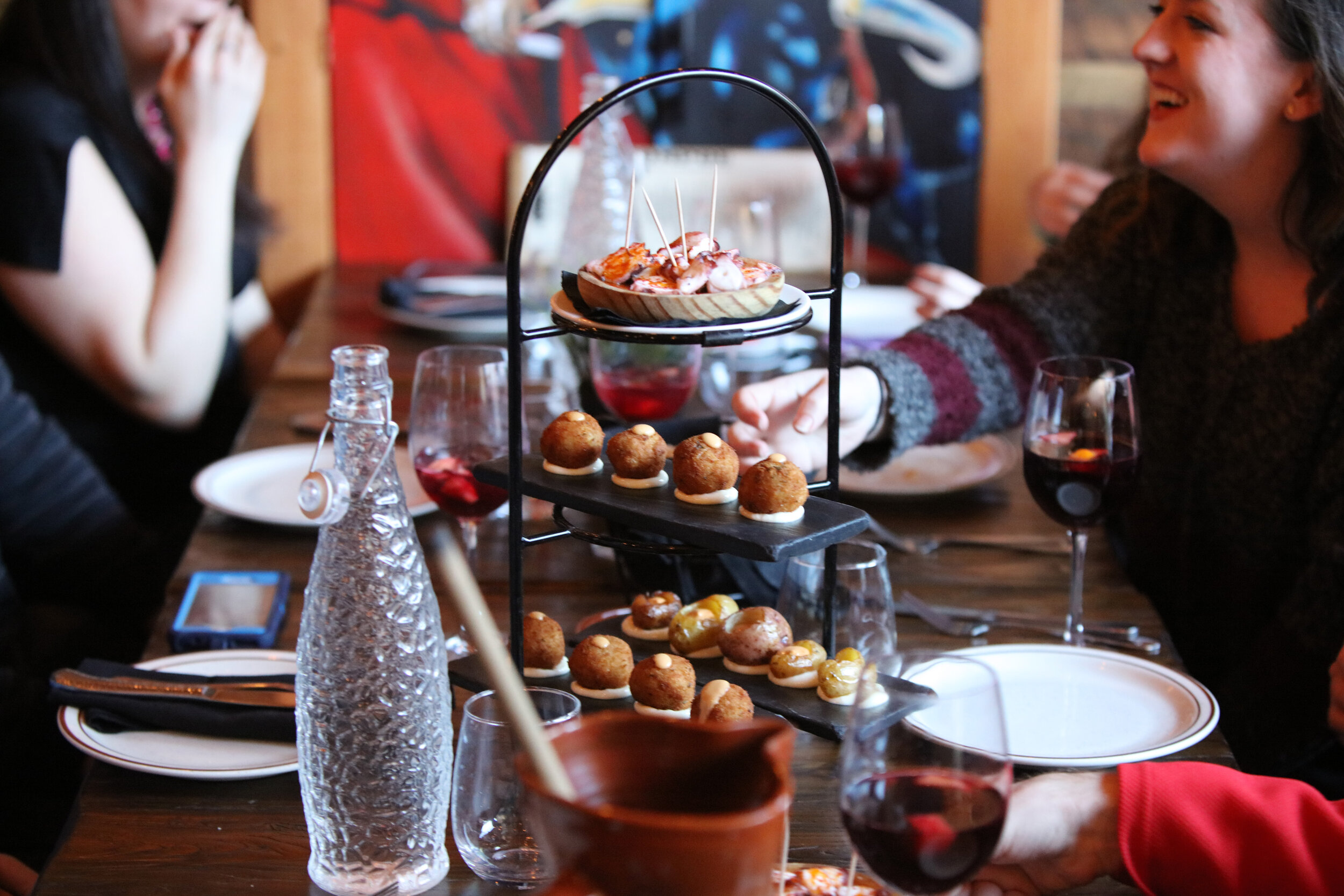

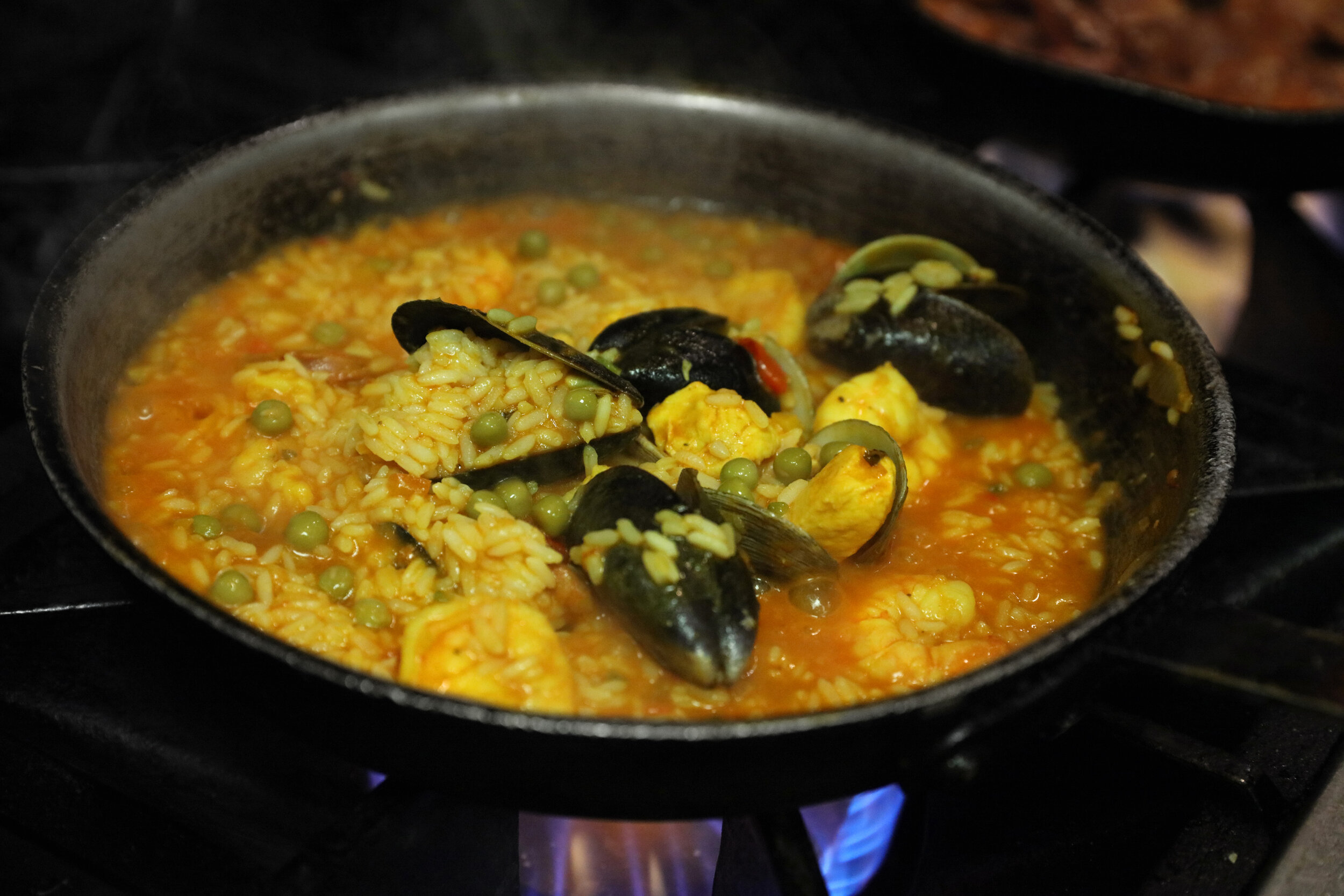
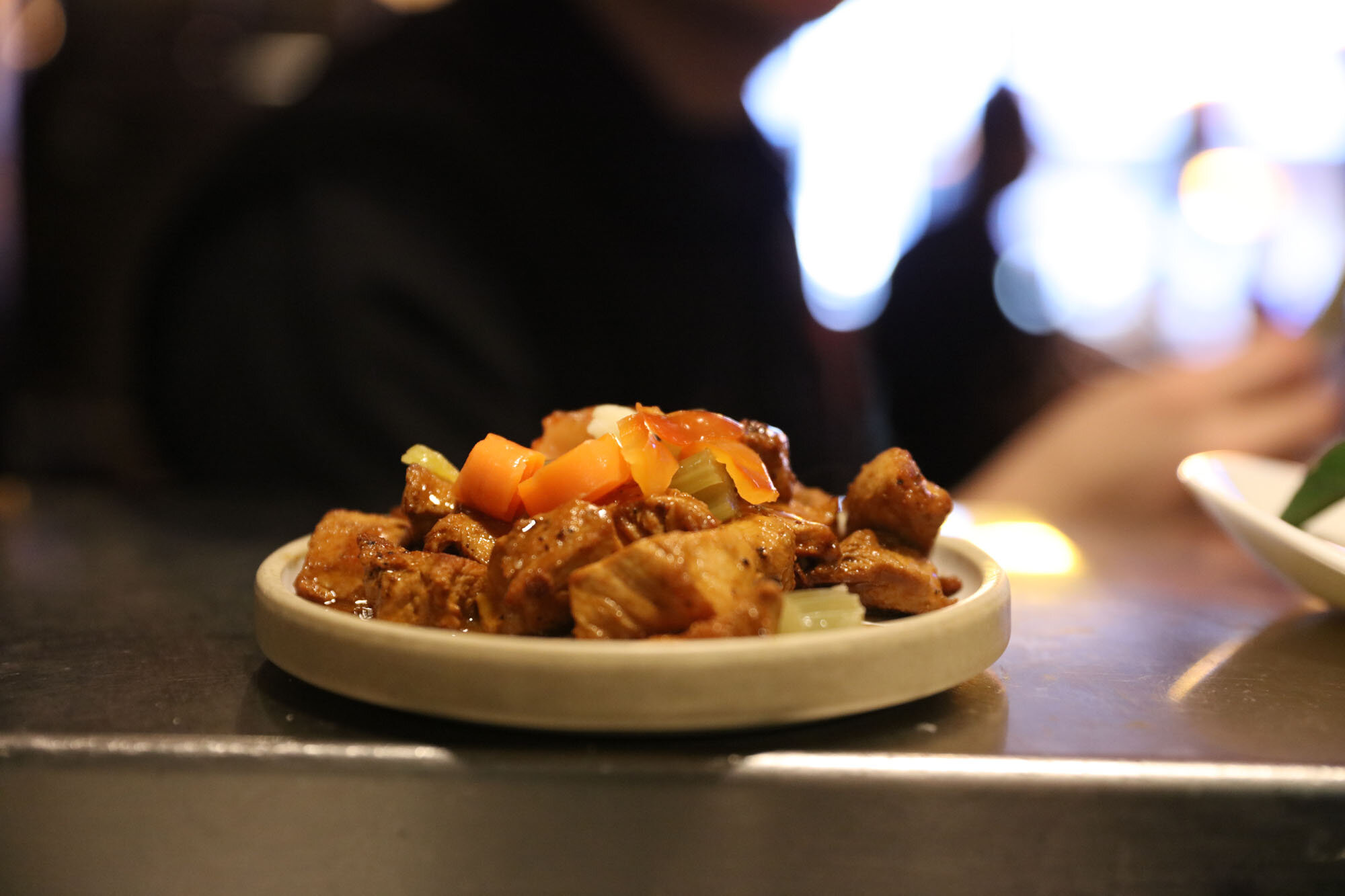
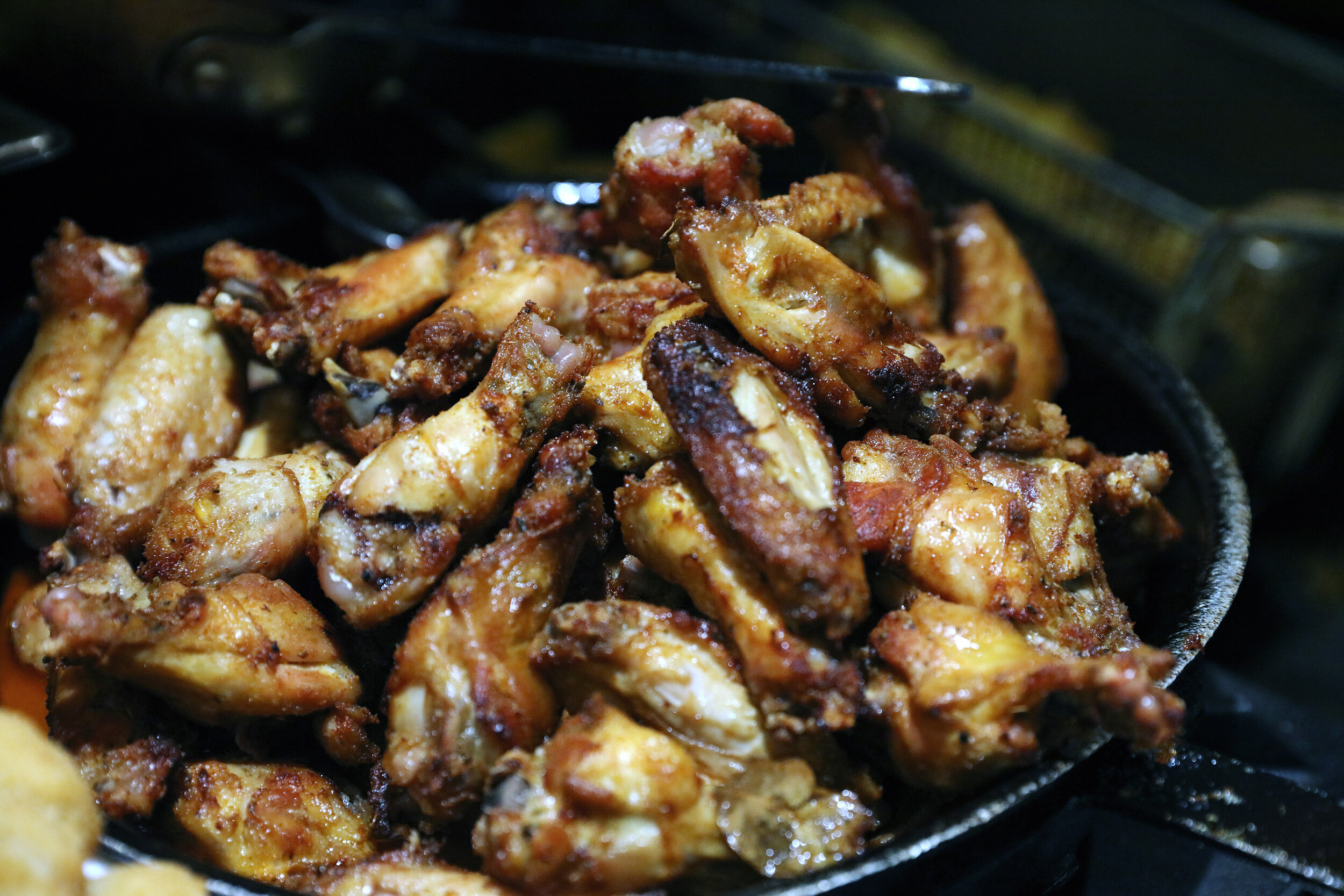
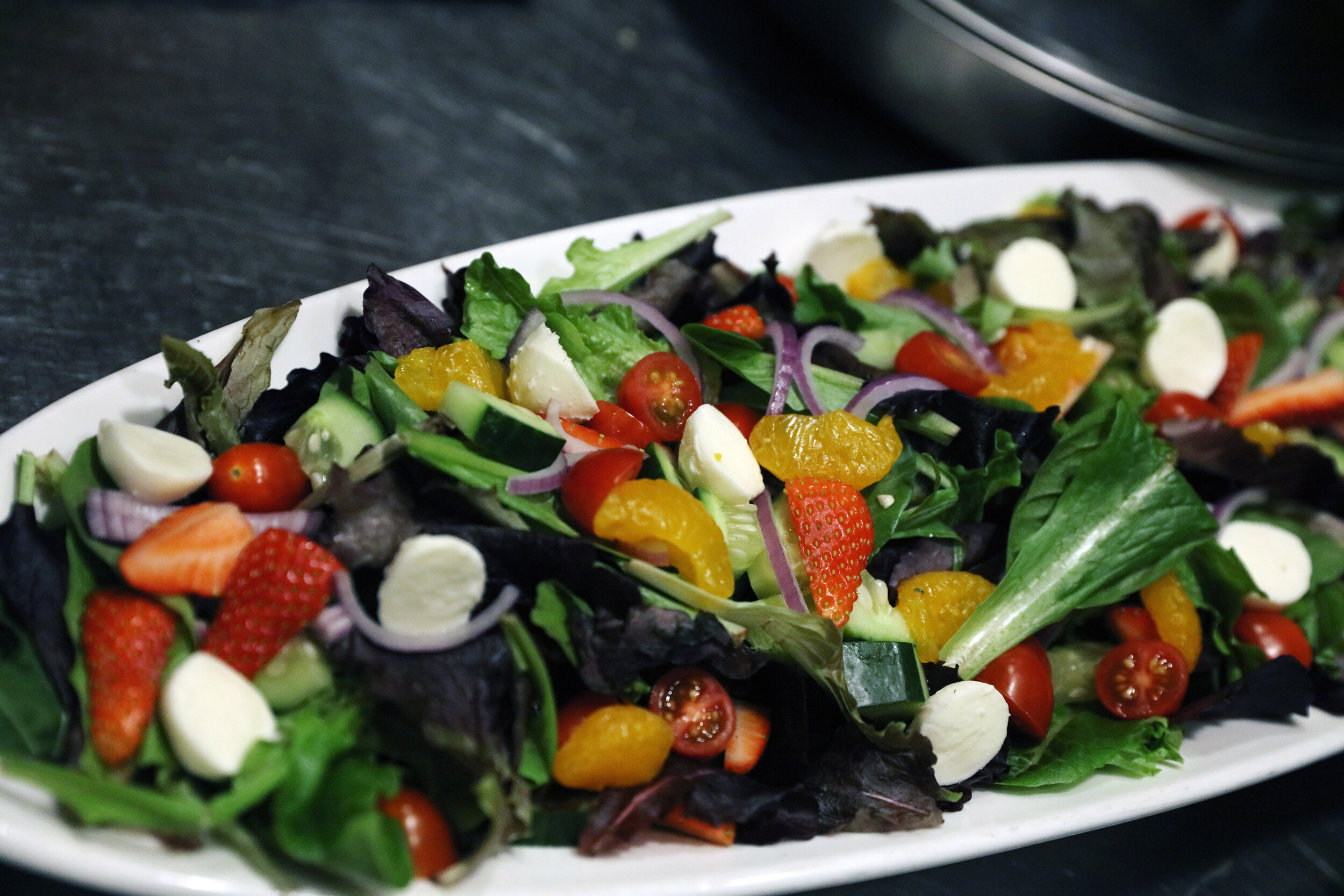
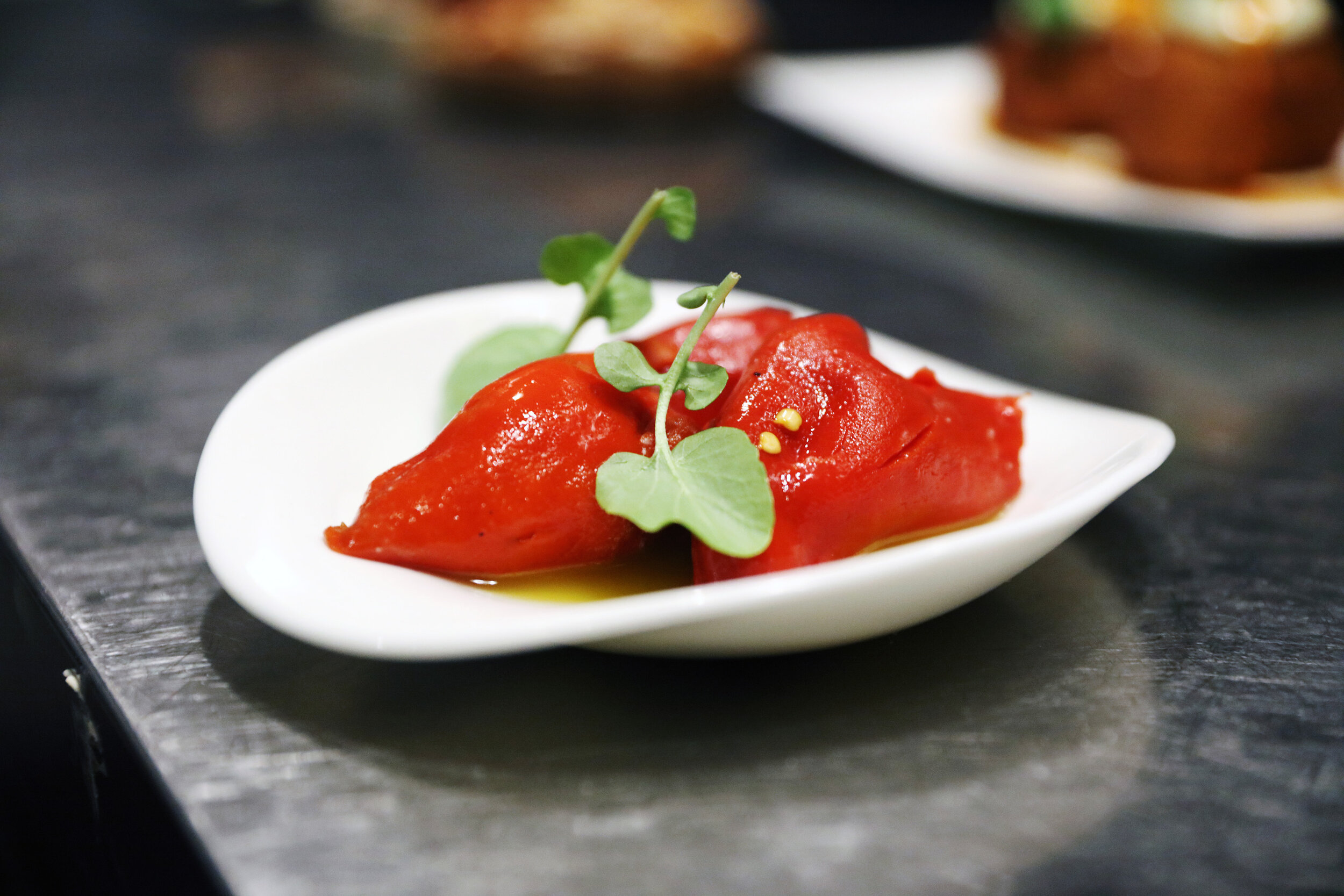
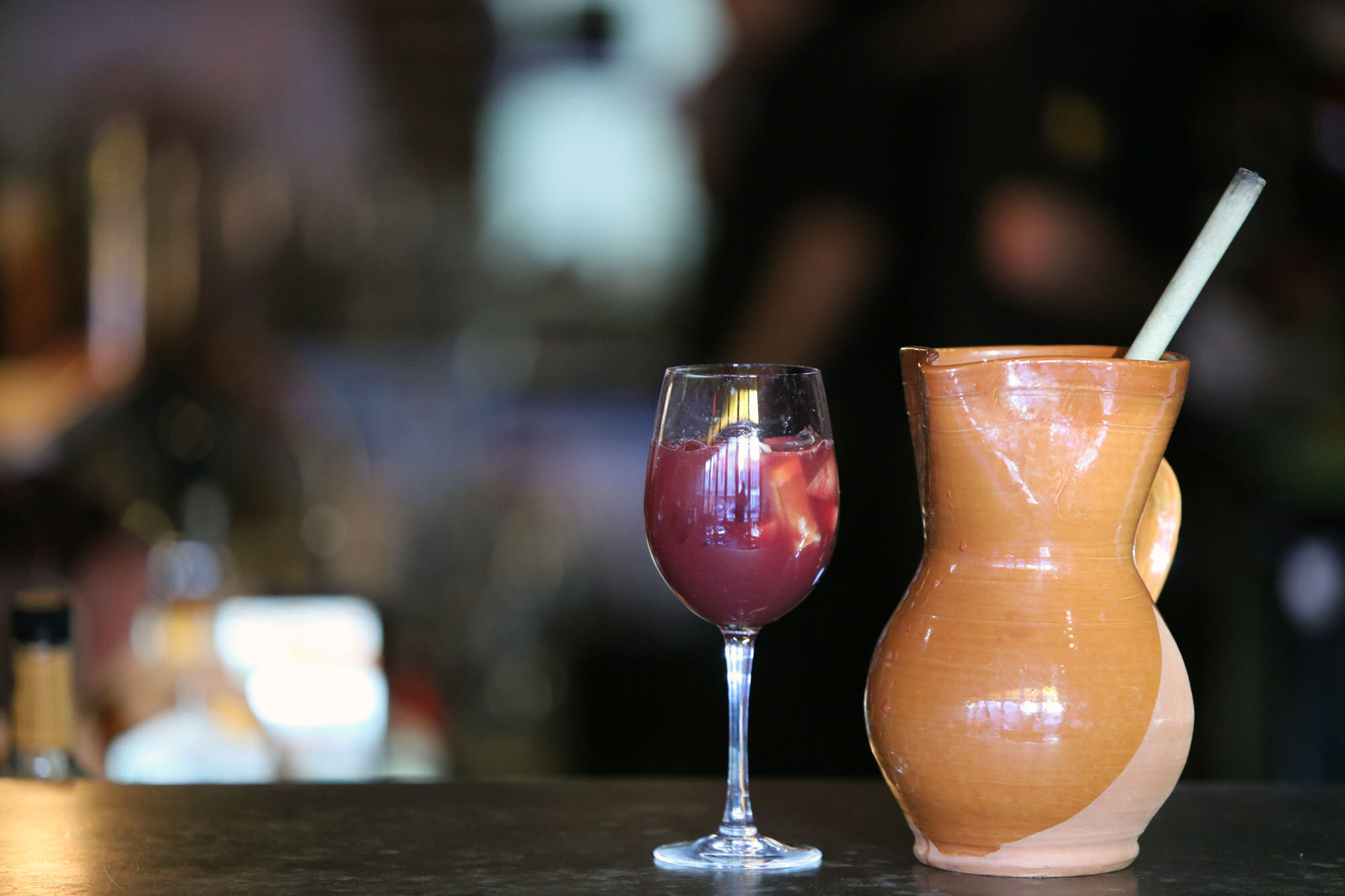
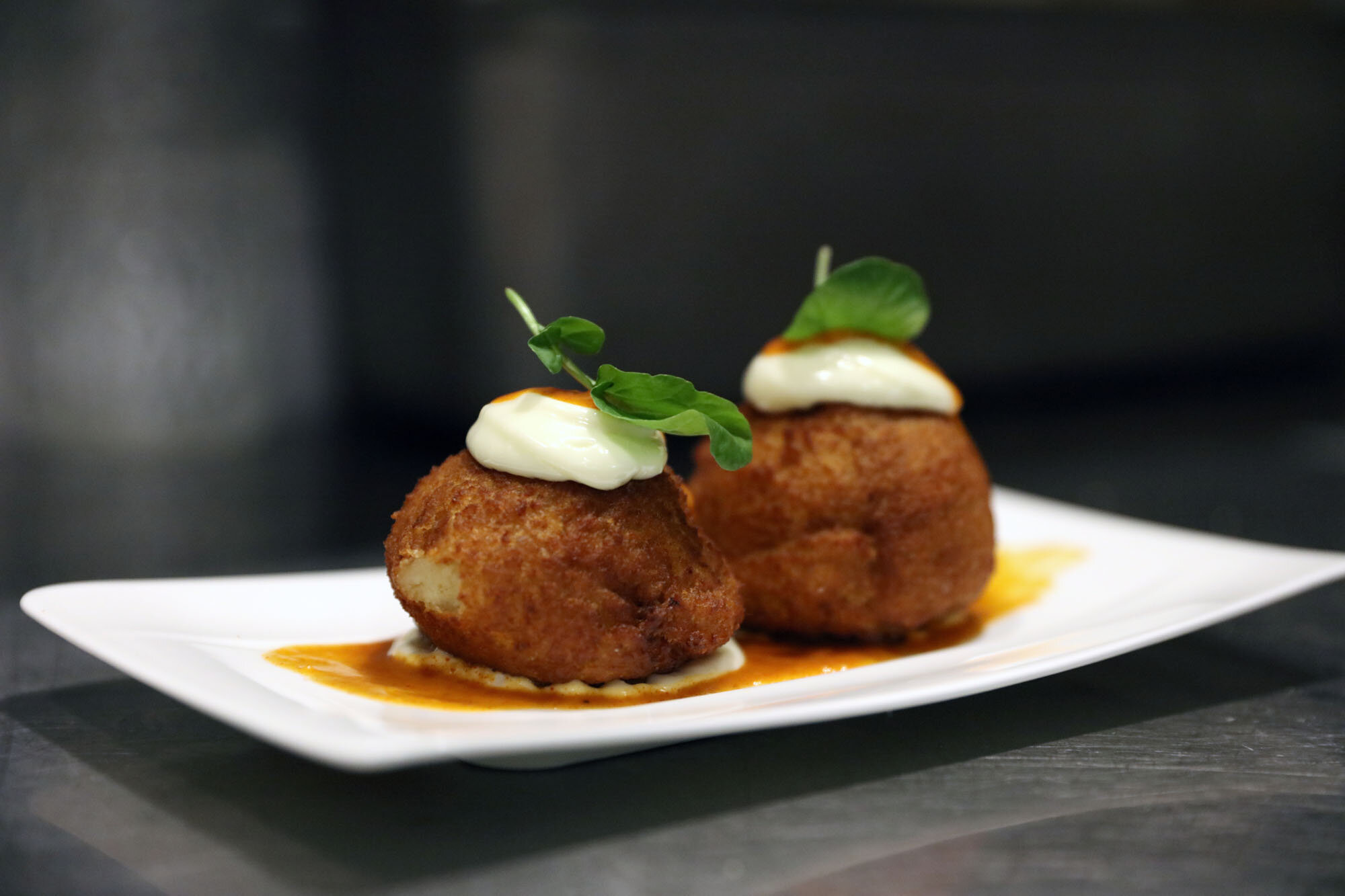
The Denizens of 77 Ferry
In 2005, in preparation for converting his sporting goods store into a restaurant and per the suggestion of his architect, Steven Yglesias removed the sheetrock installed by the former owners of the building sometime in the mid 1950s. The sheetrock at once hid and revealed episodes of the building's history and the stories it contained about the people that have passed through Ironbound over the years. The beautiful red brick and large rocks that became exposed in the first floor and basement of the building carry memories of the original occupants: those who built it, those who took refuge in it, and those who maintained and altered it.
The Rodeman family, who migrated from Hess in Germany at the end of the 19th Century, were the first residents of 77 Ferry Street. Owning the entire building, the Rodemans operated a drugstore on the first floor, while the two upper stories housed the family of 6 and their German servant. By 1910, the Rodemans’ children had grown up and left the house, and Mr. Rodeman had passed away. After his death, his widow converted the two-story residence into separate apartments to provide a source of income. To run the drugstore, Mrs. Rodeman brought in a young clerk who also resided in one of the rooms in the house. Another apartment was rented out to a second-generation Polish family of four.
By 1920, an Italian family had moved into the building. Sebastian Castello and his wife had immigrated to the U.S. around 1900. With four children, who were all born in New Jersey, the Ironbound neighborhood, which at the time hosted a growing Italian immigrant community, was an excellent place for the Castello family and business. The family lived on the top floor and the drugstore was divided into two separate businesses, one of which became Sebastian’s tailor shop.
The 1920s saw an influx of migration from the Iberian Peninsula. Over the next two decades the upper floors of 77 Ferry Street became one of the many places in the neighborhood that offered new immigrants temporary lodging. In addition to the room that was occupied by the Portuguese barber Augustino Grillo, who migrated to the U.S. in 1924 at the age of 32, the two upper stories were rented out to a steady stream of Iberian boarders. In 1930, at least 17 males between the ages of 22 and 40, all of whom immigrated from Spain, were sharing the rooms. With the exception of the boarding house's waiter and the 26-year-old cook, Delnuro Savano, the tenants were laborers who worked in the many factories and businesses in the area.
During the 1940s, dictatorships in Portugal and Spain, and forced migration caused by World War II, created a new wave of immigrants to the neighborhood, which kept the boarding house afloat. The building that once housed well-to-do German and Italian families had become a port of entry for a wider range of displaced European men who had left homes and families behind to work hard in the hopes of a brighter future and to support their families back home.
By 1943, Roy Tai, who lived a couple of blocks away at 69 Jefferson Ave, opened a laundry on the first floor — perhaps offering service to those staying in the furnished rooms upstairs. While there is no record of Mr. Tai’s nationality his surname links him to the Dai region in China and Newark’s dwindling population of ethnic Chinese who were leaving the city for the rapidly growing suburbs.
After the war, Tai’s short-lived laundry business was replaced by the Cruz and Nunes Tavern, and by 1947, with the numbers of refugees dwindling, the furnished rooms had reverted back to a family dwelling. Another business that had become essential to an immigrant neighborhood with strong ties to a wide variety of countries of origin was the travel agency. By 1951, the Central Travel Agency had moved into one of the commercial units on the first floor of 77 Ferry Street. L. Santos Gouveia lived with his family on the upper floor of the building, and his travel agency helped new immigrants arrange trips that would keep them and successive generations connected to their origins while simultaneously assisting them to integrate into their new home by providing a range of socialization services that included assistance with acquiring citizenship.
When the Yglesias family purchased the building in 1981, Steven remembers refrigeration facilities in the back rooms, a sign that the first floor might have been a supermarket or butcher before he turned it into Pegasus, a sporting goods store that benefited from the soccer-crazy culture of a neighborhood whose population was now majority Portuguese in a state that has produced the second highest number of U.S. men’s and women’s national soccer team players since the 1980s.
Steven’s vision for Mompou, like that of the entrepreneurs who occupied 77 Ferry before him, was at once rooted in the past and inspired by the potential he saw in the neighborhood’s changing demographics; re-purposing the past in the ever-shifting present of a perpetually churning immigrant neighborhood. While on the first floor, Mompou hosts an ethnically diverse professional middle-class for whom the restaurant’s modern take on tradition and identity reflects their own experience, the second-floor hosts two professionals who grew up in the area. Steven, who is now president of the Ironbound Business Improvement District, shares the space with John M. Teijido, who grew up on the third floor of 77 Ferry. After getting his law degree and a few years of experience in Florida, John returned to Ironbound and opened his law office on the second floor of his childhood home. His former apartment in the building is currently occupied by three Seton Hall students.
Food, lodgings, and essential neighborhood services are all part of a long tradition at 77 Ferry; a tradition in which tradition itself is always subject to change. And the beat goes on.
The illustrations below reimagine 77 Ferry as it has been inhabited and used since the 1890s by immigrants from Germany, Poland, Italy, China and Spain. It is a building that, like many others in the neighborhood, has been a point of entry for people from around the world, each of whom has left their imprint in the memories created within its walls.
Architectural sketch by Sahar Hosseini
Illustrations by Mary Ann Koruth
In the 1880s, The Rodeman family, Fred, his wife Mary Ann and their children emigrated from Hess, Germany, at the end of the 19th century. The Rodemans owned the building. Fred Rodeman opened a drugstore on the first floor. A servant lived with them.
By 1910 the Rodeman children had grown up and left the house, and Fred Rodeman had passed away. After his death, his widow converted the two-story residence into rented apartments as a source of income. She brought in a young clerk to assist with the drugstore and offered him a room in the house. One of the flats was rented to a second-generation Polish family of four.
By the 1920s the Italian Castello Family had replaced the old tenants. Sebastian Castello and his wife migrated to U.S. at a very young age around 1901, and soon had four children, all born in New Jersey. As a tailor Sebastian supported his family, perhaps in a shop that was located in the first floor of his house. After its life as a drugstore, the first floor of the building was divided into two smaller commercial spaces, one of which continued to be tailor shop for more than a decade.
The 1920s saw an influx of migration from the Iberian Peninsula. Over the next two decades the upper floors of 77 Ferry Street became one of the many places in the neighborhood that offered new immigrants temporary lodging. The two upper stories were rented out to a steady stream of Iberian boarders. The building that once housed well-to-do German and Italian families had become a port of entry for a wider range of displaced European men who had left homes and families behind to work hard in the hopes of a brighter future and to support their families back home.
While Mompou occupies the first floor of 77 Ferry, the second-floor hosts two professionals who grew up in the area. Steven Yglesias, who is now president of the Ironbound Business Improvement District and founder of Mompou, shares the space with John M. Teijido, who grew up on the third floor of 77 Ferry. Mr.Teijido’s former apartment in the building is currently occupied by three Seton Hall students.





